CHAPTER I: The Quiet Storm Inside: Why Modern Money Feels Overwhelming (Even When You’re Trying Your Best)
You may not talk about it often, but money shapes the quietest corners of your inner world. It sits beneath your everyday decisions what you buy, what you say yes to, what you delay, what you silently dream of and for most people, that inner conversation feels like a storm they’re supposed to weather alone.
Maybe you know this feeling:
That gentle but persistent hum of financial worries not loud enough to be a crisis, but never quite silent either. A stray payment reminder. A sudden weekend plan that goes over budget. A notification from a shopping app that pulls you into a world you weren’t planning to visit. A credit card bill that seems a little higher than you remember. Small moments, but emotionally heavy.
Modern life adds pressure in every direction. Your friends appear to be doing better. Instagram quietly reminds you that you’re not traveling enough, not investing enough, not buying enough, not “living your best life” enough. Companies spend entire budgets simply to nudge you to spend money you didn’t intend to.
Deep down, you might even wonder:
“Why does money feel so stressful when I’m actually trying?”
“Why do I feel anxious even when I’m earning decently?”
“Why is budgeting so hard when it should logically be simple?”
You are not weak, irresponsible, or late in life. You are simply human living in an environment that has been engineered to overwhelm even the smartest minds.
And that is where this journey begins.
This book isn’t about making you financially perfect. It’s about making you feel financially calm, aware, and in control slowly, steadily, with kindness.

Because budgeting in a digital age isn’t just about apps and numbers. It’s about psychology, identity, the noise around you, and the quiet storm within you.
Before we learn tools, tactics, and systems we must understand ourselves.
The Emotional Landscape: Understanding Money Anxiety in the Digital Age
If you were to ask the average working adult why money feels overwhelming, most would answer with something like:
“Things are expensive.”
“Inflation is rising.”
“My salary hasn’t kept pace.”
And those are valid truths.
But beneath the surface, the real reasons are far more psychological.
Money today is not just currency.
It’s identity.
It’s social proof.
It’s perceived stability.
It’s emotional safety.
It’s a quiet scoreboard in the background of your life.
Everyone around you is quietly performing adulthood, and money becomes the stage.
This means every financial choice feels larger than it actually is.
Even simple decisions buying an extra coffee, skipping a SIP this month, upgrading your phone don’t just feel like transactions. They feel like symbolic indicators of whether you’re “doing life right.”
This is why money anxiety has become a global phenomenon. Not only in people who are struggling to make ends meet but also among people who are earning well.
Money anxiety doesn’t care about income;
it cares about uncertainty.
And modern life has made uncertainty a default setting.
In fact, much of what we consider “financial stress” is actually psychological stress wearing a financial mask. A point we explore deeply in Financial Anxiety Is the Modern Disease: How to Heal Money Fear & Stress where constant mental load, comparison, and emotional triggers shape our spending more than actual needs.
Let’s break down these inner forces gently, without judgment.

The Three Hidden Psychological Forces That Make Money Feel Harder Than It Is
1. Decision Fatigue: Why Your Brain is Tired, Not Undisciplined
Every notification is a decision waiting to be made.
Should you order food?
Should you buy that sale item?
Should you book that trip now or wait?
Should you invest today or next month?
Studies show that the average adult makes 35,000 micro decisions a day.
You are not failing you are exhausted.
Budgeting is rarely a math problem;
it is almost always an energy problem.
Decision fatigue makes you:
- choose convenience over savings
- choose impulse over intention
- choose short term relief over long term benefit
And the digital world amplifies this tenfold.
This is why traditional budgeting methods pen and paper, monthly planning, mental math collapse under modern pressure. They require too much repeated willpower.
Which is why we later explore automated systems, dashboards, and simplified rules. (See Your Financial System Needs a Dashboard — Not Just Dreams).
2. Dopamine Hijacking: How Apps Know You Better Than You Think
There is an entire science behind your spending decisions, and most of it has nothing to do with logic.
The moment your brain perceives novelty, pleasure, or reward, it releases dopamine a neurotransmitter that pushes you toward action.
Brands, apps, and platforms intentionally use:
- infinite scroll
- flash sales
- notification badges
- countdown timers
- “Only 1 left” urgency
- curated recommendations based on your browsing psychology
You’re not just buying a product.
You’re buying a momentary emotional state.
Once you understand this, the shame dissolves. You stop blaming yourself and start recognizing how modern systems are designed.
This understanding becomes grounding, not discouraging because knowledge gives you power. This is the same emotional architecture explored in Emotional Spending Psychology: Why We Buy What We Don’t Need.
3. Mental Accounting: Your Brain Divides Money Emotionally, Not Mathematically
Behavioral economist Richard Thaler famously discovered “mental accounting” the idea that we treat money differently depending on how we emotionally categorize it.
For example:
- A ₹500 online discount feels like a victory
- A ₹500 increase in rent feels like a burden
- A ₹200 impulse snack feels harmless
- A ₹200 SIP feels restrictive
Logically, ₹200 is ₹200.
Emotionally, those transactions aren’t the same.
This is why you can overspend in one category while simultaneously feeling unable to invest or save.
You’re not inconsistent.
Your emotional brain simply uses a different accounting system than your rational brain.
The goal of budgeting in the digital age is to align these two systems, not fight them. Later chapters will show you exactly how to create this alignment through digital tools, automated decisions, and emotionally comfortable planning frameworks.
The Rational Side: Compounding and the Invisibility of Money
Now let’s bring in logic not to defeat emotion, but to balance it.
Most people underestimate how much small decisions compound.
We usually think budgeting is about controlling big numbers. In reality, it’s about gently managing the tiny leaks.
Consider this:
If you overspend by only ₹150 per day, that’s:
₹150 × 365 = ₹54,750 per year
Meanwhile, a simple SIP of ₹4,000/month (₹133/day) for 10 years at a reasonable market return (12%) grows to approximately ₹9.3 lakh.
So here’s the irony:
The same daily spending habit that feels “harmless” can cost you almost ₹10 lakh in missed wealth over a decade.
This is not guilt driven math.
This is awareness driven math.
Emotionally, ₹150 feels invisible.
Mathematically, it is powerful.
This is the same quiet compounding that we explain in The Path to Real Wealth: Why Patience and Compounding Beat Shortcuts a reminder that small, steady patterns shape big outcomes.
Most people don’t struggle because they lack money.
They struggle because they lack visibility.
Digitally, this invisibility is amplified:
- Payments happen automatically
- UPI is frictionless
- Subscription renewals hide in email
- EMI cycles run silently
- Apps subtract money faster than you realize
When money becomes invisible, anxiety becomes inevitable.
This is why so many financially responsible people still feel overwhelmed.
Which brings us to the heart of modern budgeting:
The goal is not to restrict yourself.
The goal is to make money visible again.
The Digital Age: A Double Edged Sword for Finances
The digital world has created two opposite realities simultaneously:
Reality 1 Money flows easier than ever
UPI, credit cards, BNPL, subscriptions, instant checkout, and 1 click payments make life convenient but emotionally expensive.
Reality 2 Money management is more powerful than ever
You now have access to tools our parents never had:
- budgeting apps
- spending trackers
- SIP automation
- digital dashboards
- financial journals
- investment platforms
- AI based insights
- category trackers
- subscription managers
You need a system, not more willpower.
This is where budgeting in the digital age becomes transformative.
You’re not meant to manually track money anymore.
You’re meant to design an ecosystem that handles it for you.
Later chapters will show:
- how to choose the right apps
- how to build a personal financial dashboard
- how to automate your money flow
- how to reduce decision fatigue
- how to integrate emotional psychology into your budget
- how to simplify your habits so you don’t burn out
- how to create calm even on low or inconsistent income
But before that, we must understand the emotional truth underlying all of this:
Money is emotional before it is mathematical.
Money is psychological before it is strategic.
Money is internal before it is external.
The Emotional Reveal: What You’re Actually Seeking When You Seek Financial Control
When people say, “I want to save more,” they’re not asking for a number.
They’re asking for safety.
When they say, “I want to invest consistently,” they want confidence.
When they say, “I need to stop overspending,” they want self trust.
When they say, “I want a budget,” they want clarity not rules.
This deeper emotional understanding is what connects this chapter with pieces like How to Measure Real Progress in Life When Money Isn’t Enough because your financial choices are not separate from your life journey. They are intertwined.
Once we acknowledge what you’re truly seeking, budgeting stops feeling like punishment and starts feeling like self respect.
The Transformation Begins: From Financial Shame to Awareness
Many readers come here with shame.
They think:
“I should’ve known better.”
“I should’ve saved more.”
“I should’ve been more disciplined.”
But here’s a truth few people tell you:
You can’t change your financial habits with shame.
But you can change them with awareness.
Shame freezes.
Awareness liberates.
You don’t need to be perfect.
You don’t need to overhaul everything overnight.
You don’t need to suddenly become hyper disciplined.
You only need to be:
- aware of your patterns
- aware of your triggers
- aware of your emotional relationship with money
- aware of how the digital environment shapes your behavior
- aware of your quiet financial desires
This is the foundation.
This is where real budgeting begins.
Not in numbers.
In understanding.
This is also why young Indians today are reshaping financial culture a shift beautifully explored in How Gen Z and Young Professionals Manage Money: An Unseen Indian Financial Revolution.
Awareness is not a small change.
Awareness is the first form of wealth.
The Closing Arc of Chapter 1: Your Inner Grounding
If there is one message I want you to carry into the next chapter, it is this:
You are not behind.
You are not failing.
You are not alone.
You are living in an overstimulated world one that pulls your attention, hijacks your emotions, distracts your intentions, and confuses your priorities.
Feeling overwhelmed by money is not a personal flaw.
It is a universal experience.
This journey is not about bulletproof discipline.
It is about gentle clarity.
It is about creating peace.
It is about designing your environment so your best decisions become your default decisions.
And slowly, you will notice:
- spending becomes intentional
- saving becomes natural
- investing becomes habitual
- income becomes purposeful
- financial clarity becomes emotional clarity
This is where budgeting becomes not a restriction, but a release.
In the next chapter, we will explore:
The Psychology of Intentional Spending: How to Understand Your Triggers, Patterns & Emotional Money Cycles.
But before we begin Chapter 2, pause for a moment.
Take one slow breath.
Feel the storm quiet down even a little.
You’ve already begun.
CHAPTER II: The Psychology of Intentional Spending: Understanding Your Triggers, Patterns & Emotional Money Cycles
Because spending is never just the physical act of exchanging money it is always an emotional conversation between who you are, who you’ve been, and who you’re trying to become.
We often think, “I overspend because I lack discipline” or “I make impulse purchases because I’m weak.”
But human behavior is never that shallow.
You don’t overspend because you’re careless.
You overspend because something inside you is trying to soothe, express, or compensate for an emotional experience.
Once you understand that, the shame begins to melt, and clarity finally arrives.
This chapter is an invitation to look inward gently, truthfully, and without fear so that you can shape spending decisions that feel intentional, grounded, and true to your values.
The Emotional Roots of Spending: Money as Comfort, Identity, Escape, and Expression
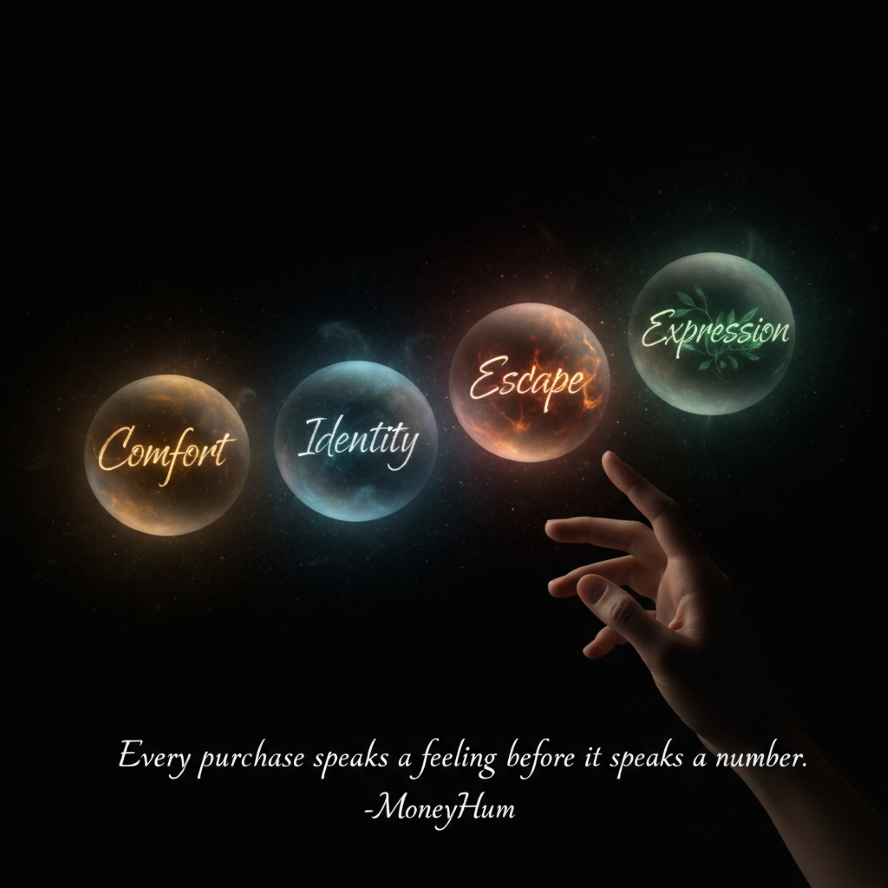
If you look back at your past month of spending, you’ll notice something subtle:
Some expenses make you feel peaceful, aligned, and satisfied.
Others leave you feeling a little heavy, regretful, or unsettled.
Why does this happen?
Because not every expense is created by the same emotional origin.
Every spending decision comes from one of four inner states:
- Comfort
- Identity
- Escape
- Expression
Understanding these four helps you decode your patterns without judgment.
1. Spending as Comfort (The Soft Escape)
This is the most universal emotional trigger.
You’ve had a long week.
You’re mentally exhausted.
You crave relief.
Your brain chooses the quickest, easiest form of comfort food delivery, an online order, a small indulgence, or that “feel good” purchase you don’t need.
There’s a reason food delivery apps report peak order spikes after 9 pm:
humans self soothe through convenience.
But the problem isn’t the comfort.
It’s the absence of awareness.
You’re not buying the thing.
You’re buying a moment of exhale.
This is why learning emotional spending patterns is so important something explored deeply in Emotional Spending Psychology: Why We Buy What We Don’t Need.
2. Spending as Identity (The Performance Layer)
We don’t just buy objects.
We buy versions of ourselves.
That new outfit before a trip.
That phone upgrade when everyone else has it.
Gifts that feel more expensive than necessary.
Monthly subscription for a hobby you aspire to but never actually do.
Fancy cafés that become less about coffee and more about belonging.
Identity spending isn’t wrong.
We all want to belong, to grow, to express ourselves.
But when spending becomes a performance instead of a choice when it becomes about proving something to others it slowly drains financial peace.
This dynamic is the quiet emotional engine behind lifestyle creep, a pattern deeply intertwined with social comparison, something also discussed in How Gen Z and Young Professionals Manage Money: An Unseen Indian Financial Revolution.
3. Spending as Escape (The Silent Trigger)
Not all spending is loud.
Sometimes it happens in tiny, silent ways especially when you’re trying to avoid something difficult:
- the difficult conversation you’ve been delaying
- the task you’re procrastinating
- the loneliness that creeps in at night
- the emptiness after a draining day
- the emotional discomfort you can’t name
You scroll, and buy.
Not because you really want something.
But because your brain is running from an emotion it hasn’t processed.
This is how overspending becomes a form of emotional anesthesia.
When escape becomes a habit, financial clarity dims, and budgeting feels impossible not because of numbers, but because of unprocessed emotions.
This emotional cycle shapes modern financial anxiety, explored deeply in Financial Anxiety Is the Modern Disease: How to Heal Money Fear & Stress.
4. Spending as Expression (Who You Are When You Feel at Your Best)
Not all emotional spending is problematic.
In fact, some expenses are reflections of your truest, most grounded self:
- investing in a skill you genuinely want
- spending on health, fitness, therapy, or self care
- buying tools that genuinely improve your life
- experiences that deepen relationships
- investing in your future through SIPs or emergency funds
These are not weaknesses they’re strengths.
Intentional spending flows from self respect.
Escapist spending flows from self avoidance.
The goal is not to eliminate emotion.
The goal is to ensure emotion is aligned with intention.
This is the difference between spending that gives you peace and spending that steals it.
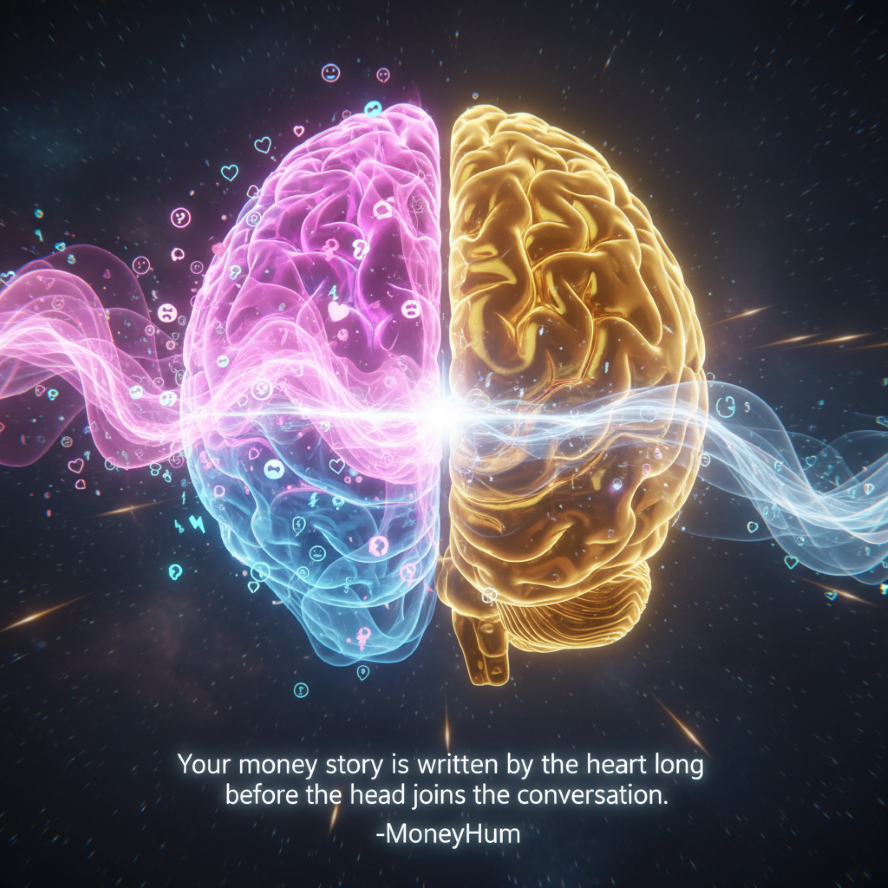
The Actual Psychology: Why Your Brain Prefers Spending Over Saving
There are three scientific reasons why saving feels harder than spending.
Understanding them changes everything.
1. Your Brain Prefers Immediate Rewards (Hyperbolic Discounting)
Think of it this way:
Your brain values ₹500 today more than ₹1500 next month even though that makes no rational sense.
This is known as hyperbolic discounting, a well studied cognitive bias where humans heavily discount the value of future rewards.
It’s why:
- we procrastinate
- we overspend
- we delay investing
- we choose instant relief over long term benefit
Saving feels like giving money to your future self a person your emotional brain barely recognizes.
This is where automated investing becomes life changing (more on that in later chapters). It eliminates negotiation with your emotional brain.
For now, just know this:
If saving feels unnatural, it’s not a character flaw.
It’s basic neurology.
2. Your Brain Overestimates Pain (Loss Aversion)
Humans feel the pain of loss twice as intensely as the joy of gain.
This is why:
- cutting down your budget feels painful
- deleting a shopping app feels suffocating
- removing an expense feels like scarcity
- investing feels like “losing” present comfort
Your brain is not wired to reduce expenses easily.
This is biological, not moral.
When you understand this, you stop blaming yourself and start working with your psychology instead of against it.
This principle also explains why shortcuts appear so seductive, explored in Why You Keep Chasing Quick Profits because risk feels more attractive than discipline when loss aversion is activated.
3. Your Emotional Brain Makes Money Decisions, Not Your Logical Brain
Neuroscientists have found that 95% of financial decisions are subconscious.
This means:
You don’t think your way into financial trouble;
you feel your way into it.
Your logical brain (prefrontal cortex) wants structure:
SIPs, budgets, categories, dashboards, safety.
Your emotional brain (limbic system) wants relief:
comfort, escape, stimulation, approval, distraction.
Budgeting becomes a tug of war between these two inner worlds.
Intentional spending emerges only when these parts of you begin working together a process we’ll build step by step throughout this book.
Your Personal Triggers: How to Recognize What Drives Your Spending
Before you can change your financial behavior, you must understand it.
Below are the five most common spending triggers hidden but powerful. Not to judge yourself, but to recognize your patterns with kindness.
1. Fatigue Trigger (Low Energy = High Spending)
When you’re tired, your brain’s self control system shuts down.
This is why late night spending is so common.
Look at your last 10 impulse purchases.
When did they happen?
Most likely:
- late at night
- during a stressful day
- after back to back tasks
- on weekends when your mental load drops
- when you were emotionally drained
Exhaustion makes spending feel like relief.
2. Stress Trigger (Cortisol Purchases)
Your brain tries to soothe stress by creating small dopamine spikes.
This leads to purchases that feel like:
“I deserve this.”
“I need a break.”
“This will fix my mood.”
But it rarely does.
This stress spend pattern is one reason financial anxiety spirals stress → spending → guilt → more stress.
Understanding the cycle breaks the cycle.
3. Loneliness Trigger (The Silent One)
This is one no one talks about.
Humans use spending to fill emotional gaps:
- ordering food when lonely
- buying something to feel “seen”
- upgrading something to feel in control
- purchasing something just to feel movement
Loneliness spending is a form of self companioning a comforting but expensive habit.
4. Reward Trigger (The “I deserve it” impulse)
Humans are designed to reward themselves after effort.
But when your only form of reward is consumption, your spending becomes emotional compensation.
There are healthier, cheaper, more fulfilling ways to reward yourself habits we will build in Chapter 4 and 5.
5. Identity Trigger (Who you want to be)
You spend differently when you’re trying to feel like a particular version of yourself:
The productive one
The social one
The aesthetic one
The successful one
The “I’ve got it together” one
Identity driven spending isn’t wrong.
It just needs awareness otherwise it silently drains financial peace.
Turning Awareness Into Power: From Emotional Spending to Intentional Spending
The goal is not to eliminate emotional spending that’s impossible.
The goal is to create distance between the emotion and the transaction.
Just a few seconds of awareness can save you thousands every year.
Think of intentional spending as a simple three step inner dialogue:
STEP 1 NOTICE
“What am I feeling right now?”
Tired? Lonely? Bored? Excited? Stressed?
STEP 2 NAME IT
“Is this purchase coming from comfort, identity, escape, or expression?”
STEP 3 CHOOSE
“Do I want to buy this because I value it, or because I want relief?”
This tiny pause transforms everything.
It re engages your logical brain.
It softens emotional impulsivity.
It turns spending into a calm conversation with yourself.
This is what intentional spending really means not restriction, not guilt, not austerity.
Just clarity.
The Math of Intentional Spending: Using the 50/30/20 Rule
Money psychology can be emotional but it must eventually meet logic.
Once you understand your emotional drivers, you need a structure that gives shape to your spending.
This is where frameworks like the
50/30/20 Rule
become powerful.
Simple, scalable, and psychologically friendly something explored fully in The 50/30/20 Rule: How Behavioral Finance Creates Financial Peace in 2025.
But for now, let’s ground the structure:
- 50% → Needs
- 30% → Wants
- 20% → Savings/Investments
Why does this work so well?
Because it aligns emotional need with rational clarity.
Wants are not eliminated.
They are contained.
Savings are not negotiable.
They are automatic.
Needs are not stressful.
They are planned.
This creates psychological safety, which reduces impulsive spending.
Even if your income is low or irregular, a simplified version of the same rule can work:
- Core Survival (60–70%)
- Lifestyle (15–25%)
- Growth/Savings (10–20%)
We refine this further in later chapters.
The Transformation Moment: Where Emotion Finally Meets Intention
Once you understand your triggers, acknowledge your emotional patterns, and build visibility, something subtle starts changing inside you.
You stop fearing bills.
You stop judging yourself.
You stop feeling embarrassed.
You stop thinking you’re “bad with money.”
You begin feeling grounded.
Clear.
In control.
Emotional clarity builds financial clarity.
Financial clarity builds emotional maturity.
And mature money habits create a calm life.
This is the shift we move toward in the coming chapters building digital systems, automated flows, and simple tools that support your best self.
Intentional spending isn’t a technique.
It is an identity.
It is you, choosing in alignment with who you want to become.
Closing Arc of Chapter 2
If Chapter 1 quieted the storm, Chapter 2 gave you the map.
You now know:
- why you spend the way you do
- how your emotional patterns shape money decisions
- how your brain works against you
- how to gently bring it back into alignment
- how triggers shape habits
- how awareness transforms everything
This is the foundation for all the digital tools we will introduce later.
For now, remember:
You do not need to be perfect.
You only need to be aware.
Awareness is the first step toward intentional budgeting.
It is also the first step toward emotional freedom.
CHAPTER III: The Digital Layer: How Apps, Dashboards & Automation Create Calm, Reduce Willpower, and Transform Your Financial Life
Chapter 3 is where you learn how to build the structures that calm the storm not by fighting your emotions, but by designing a digital world that supports them.
Because let’s be honest:
In today’s world, money management isn’t about discipline anymore.
It’s about ease, automation, visibility, and emotional relief.
The digital age has made spending frictionless.
So the digital age must also make budgeting frictionless.
The tools exist.
The systems exist.
You simply need to assemble them into a personal ecosystem.
This chapter is your guide to building such an ecosystem one that reduces decision fatigue, prevents emotional overspending, and gives you a sense of quiet control.
The Emotional Problem Digital Systems Are Designed to Solve
Humans are not naturally good at repetitive tasks.
We forget.
We delay.
We get overwhelmed.
We get distracted.
We lose motivation.
We seek comfort when stressed.
This is why traditional budgeting writing expenses, updating spreadsheets, manually transferring savings collapses after a few weeks.
Not because you are weak.
But because your brain is not designed for:
- constant monitoring
- endless microdecisions
- long term restraint
- repetitive calculations
- invisible money flows
- scattered financial accounts
Digital tools are not a luxury.
They are a psychological necessity.
Automation exists because your energy is limited, and your money deserves a system that doesn’t depend on your mood, stress levels, or memory.
This concept of “systems over discipline” is also the core idea behind Your Financial System Needs a Dashboard — Not Just Dreams where structure replaces stress.
The 4 Digital Pillars of Modern Budgeting: Tracking, Categorization, Automation, and Dashboards

Everything you will ever need fits into four pillars:
- Tracking (Visibility)
- Categorization (Awareness)
- Automation (Consistency)
- Dashboards (Clarity)
When all four work together, budgeting becomes effortless.
Let’s walk through each one.
1. Tracking: The Power of Seeing Everything in One Place
Most financial anxiety comes from a lack of visibility, not a lack of money.
Consider this:
If you don’t know where your money goes, your brain subconsciously assumes the worst. This is why even people with good incomes often feel broke.
Tracking is not about micromanaging.
Tracking is about calming your nervous system.
Today’s digital tools give you:
- instant expense logs
- spending charts
- category breakdowns
- alerts for unusual transactions
- subscription reminders
- bank balance sync
- UPI & card spend histories
When you see the truth, anxiety reduces by itself.
This is the psychological shift that quietly heals “financial overwhelm,” similar to the healing framework explored in Financial Anxiety Is the Modern Disease: How to Heal Money Fear & Stress.
Why tracking works (the emotional science)
When you have visibility:
- uncertainty drops
- fear drops
- guilt drops
- impulse spending drops
- confidence rises
- calm rises
Seeing the truth is grounding.
And digital tools make truth visible without effort.
2. Categorization: Turning Raw Data Into Meaning
Raw spending data is useless unless categorized.
Categorization is where patterns emerge:
You realize:
- you don’t overspend everywhere
- you overspend in three places consistently
- you’re triggered by specific emotional states
- your wants overshadow your future goals
- subscriptions quietly drain your energy
- food delivery doubles during stressful weeks
Categorization turns chaos into clarity.
Apps today automatically categorize:
- groceries
- dining
- travel
- entertainment
- shopping
- bills
- EMIs
- UPI transfers
- investments
- subscriptions
This allows you to create budgets not from guilt, but from truth.
For example:
You may discover that your spending is not “out of control” it is simply concentrated in three emotional categories.
Suddenly the problem becomes solvable.
This level of self understanding mirrors the emotional mapping explored earlier in Emotional Spending Psychology: Why We Buy What We Don’t Need.
3. Automation: Your Future Self’s Best Friend

If you remember one thing from this entire chapter, let it be this:
Automation is not a feature. Automation is emotional protection.
Because when you automate:
- savings happen without negotiating with yourself
- investments happen without second thoughts
- bills get paid before they become stress
- credit card dues don’t turn into anxiety
- your financial growth becomes inevitable
Automation removes emotion from essential decisions.
This is why SIPs work so well as explained in Build a Strong SIP Habit: Your Simple 12-Month Plan because they eliminate hesitation.
The rule is simple:
Automate everything that should happen regularly.
This includes:
- SIPs
- emergency fund deposits
- credit card payments
- recurring investments
- rent
- savings transfers
- subscription renewals
Why automation works psychologically
Because it bypasses:
- lack of discipline
- forgetfulness
- emotional spending impulses
- anxiety driven avoidance
- procrastination
- fatigue
When your money flow is automatic, your life becomes calmer.
4. Dashboards: The Single Most Important Digital Tool for Clarity
If tracking is awareness, and automation is consistency, then dashboards are clarity.
A dashboard is a place where you see everything at a glance:
- income
- expenses
- investments
- savings rate
- net worth
- upcoming bills
- goals
- category spending
- subscription renewals
Dashboards create simplicity.
Dashboards create peace.
Dashboards create control.
This is why dashboards are emphasized so strongly in the MoneyHum ecosystem deeply explored in Your Financial System Needs a Dashboard — Not Just Dreams.
Once you see everything in one place, budgeting becomes an emotionally guided, not emotionally overwhelmed experience.
The Digital Tools That Support These Four Pillars
You don’t need 20 apps.
You need 4 types of tools:
1. A Spending Tracker / Budgeting App
(To track and categorize)
2. A Banking App & UPI System
(The foundation of all inflows/outflows)
3. An Investment Platform
(SIPs, mutual funds, index funds, long term investing)
4. A Dashboard System
(This could be an app feature or your own created dashboard)
Pick tools that feel intuitive, simple, and emotionally light.
“Emotionally light” means:
- not cluttered
- not overwhelming
- not aggressive
- not noisy
- not complicated
Tools should give you clarity, not pressure.
Digital Behavior Design: How Apps Shape Your Spending
Most people underestimate how much digital structure influences behavior.
Your apps influence your spending more than your willpower.
For example:
UPI makes spending frictionless
You spend more when the friction is low.
E commerce apps create urgency loops
Flash sales, limited time deals, countdown timers.
Food apps amplify emotional triggers
LATE NIGHT = dopamine
DISCOUNTS = reward
QUICK DELIVERY = relief
Subscription models create invisible expenses
Small monthly deductions that add up silently.
Social media influences identity driven spending
Aesthetic lifestyles → aspirational purchases.
Banking apps enable instant credit access
BNPL, credit lines, easy loans.
Understanding this helps you design your environment intentionally instead of being controlled by it.
This emotional digital interplay also explains why many investors chase shortcuts, explored in Why You Keep Chasing Quick Profits because digital systems reward instant gratification.
Creating a Digital Money Ecosystem That Supports Your Best Self
Let’s build a simple, elegant framework:
STEP 1: Your Money Comes In and Goes to the Right Places Automatically
Imagine your income arriving monthly and instantly getting divided:
- X% → Bills
- Y% → Investments
- Z% → Savings
- Remaining → Lifestyle
You never “feel” the movement.
You just feel calm.
This is intentional budgeting.
This is emotional budgeting.
This is digital age budgeting.
STEP 2: Your Apps Reflect Real Life, Not Perfection
Don’t chase the perfect system.
Chase the support system.
For example:
- Add broad categories instead of micromanaging
- Build a simple dashboard with only what matters
- Create automated rules for convenience
- Use reminders sparingly to reduce stress
- Keep your investing platform clean and uncluttered
- Limit your number of cards and accounts
Digital minimalism creates financial peace.
STEP 3: Your Dashboard Becomes Your Anchor Point
Every Sunday (or any quiet day), spend 10 minutes reviewing:
- your expenses
- your categories
- your overspending triggers
- upcoming bills
- investment progress
- your savings rate
Just 10 minutes a week.
This is not discipline.
This is ritual.
This 10 minute check in replaces hours of stress later.
This is also the technique used by high performers who want to avoid burnout a theme explored in The Hidden Cost of Constant Hustle.
The Mathematical Clarity of the Digital Age
Let’s switch from psychology to math gently.
Here’s the truth most adults never realize:
Digital automation can increase your annual savings rate by 20–35% WITHOUT changing your lifestyle.
How?
Because:
- you eliminate forgetfulness
- you eliminate late fees
- you eliminate timing mistakes
- you eliminate impulse driven cash flow
- you eliminate emotional decisions
- you eliminate unmonitored spending
In India alone, people lose thousands each year to:
- missed payment charges
- hidden subscriptions
- emotional purchases
- random UPI spend
- impulsive food delivery
- payday over spending
Digital systems plug these leaks automatically.
This is why building an emergency fund becomes easier when automated as discussed in Emergency Fund Mastery because the process becomes frictionless.
The Transformation Moment: The Day Your Money Starts Working for You
There comes a moment and it happens sooner than you think when your digital systems become so aligned, you feel something you haven’t felt for years:
Quiet financial peace.
You’ll wake up one day and notice:
- your SIPs ran automatically
- your dashboard shows stable progress
- your spending stayed within intention
- your subscriptions are under control
- your bills are paid
- your goals feel closer
- your anxiety is lower
- your savings are growing
Not because you worked harder.
But because your systems worked for you.
This is what modern budgeting really is.
Not discipline.
Not restriction.
Not guilt.
Just thoughtful design.
CHAPTER IV: Building Your Personal Budgeting Ecosystem: A Step-by-Step Framework for Calm, Intentional, Digital Money Management
By now, you’ve walked through the emotional landscape of modern money, understood the psychology behind your spending, and learned how digital tools can create calm instead of chaos.
This is the moment where understanding transforms into a system.
Where insight becomes structure.
Where clarity becomes routine.
Where the storm inside you finally begins to soften into stillness.
A budgeting ecosystem is not a rulebook.
It is a living environment designed to protect your emotional energy, simplify your decisions, and make your best financial habits automatic.
The goal is simple:
Create a system that works even on your worst days.
Because real financial peace does not come from discipline.
It comes from design.
Why You Need a Budgeting Ecosystem and Not Just a Budget
Most people think budgeting is a list or a plan.
But budgeting is actually a behavioral environment.
A real budgeting system must:
- reduce decision fatigue
- prevent triggers from turning into spending
- make important tasks automated
- make money visible
- reduce emotional overwhelm
- support you on low energy days
- simplify choices
- give you predictability
- build self trust
If a budget requires willpower, it will fail.
If a budget requires discipline, it will slowly collapse.
But if a budget is supported by an ecosystem tools, habits, automation, structure it becomes effortless.
This shift from “control” to “design” is the core idea behind Your Financial System Needs a Dashboard — Not Just Dreams where the system carries the weight, not your mind.
The 5 Elements of a Personal Budgeting Ecosystem
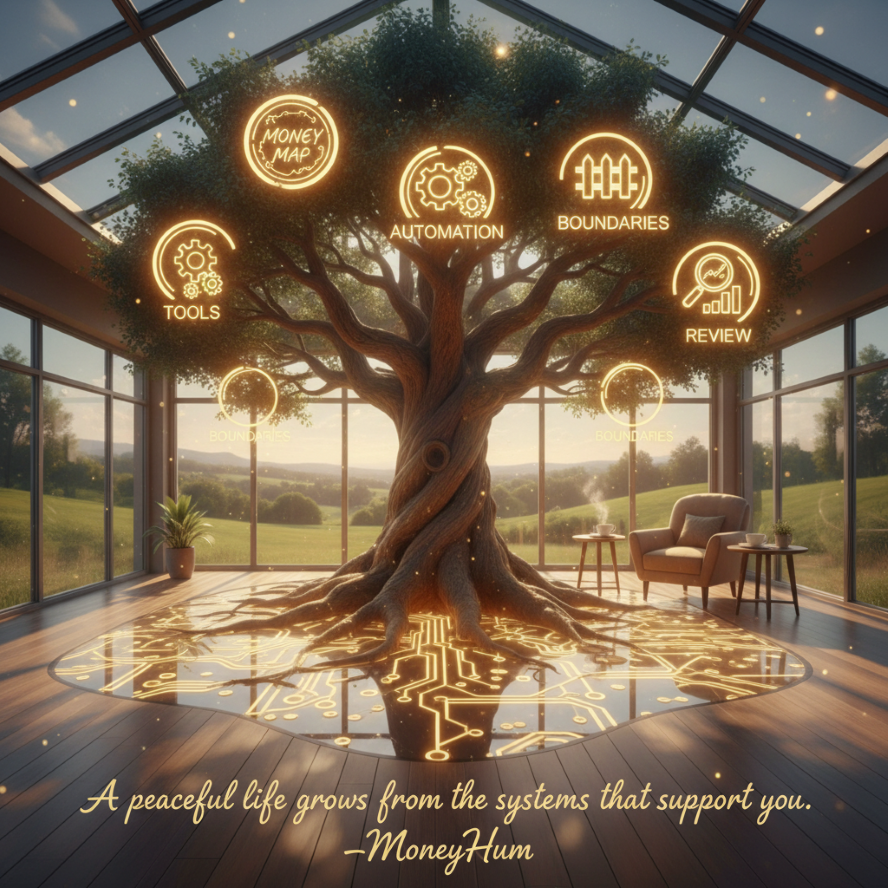
Think of this ecosystem as a gentle circle, not a rigid checklist.
- Your Money Map (Awareness)
- Your Digital Tools (Infrastructure)
- Your Automated Flows (Consistency)
- Your Spending Framework (Boundaries)
- Your Review Ritual (Reflection)
Each element supports the others, creating a balanced, psychologically friendly, and emotionally grounding financial life.
Let’s build your ecosystem step by step.
1. Your Money Map: Understanding Your Financial Flow
Before you build an ecosystem, you need a map.
A map is not a budget.
It is simply the truth gently laid out.
A money map has three parts:
A) Your Income Streams
Salary
Side income
Freelancing
Business earnings
Stipends
Family contributions (if any)
Knowing the pattern of income is more important than the amount.
B) Your Fixed Costs
These are predictable:
- rent
- EMIs
- subscriptions
- utilities
- insurance premiums
- internet/mobile
- school fees
Fixed costs reflect your obligations.
C) Your Variable Costs
These change month to month:
- groceries
- transport
- food delivery
- shopping
- self care
- travel
- entertainment
- spontaneous plans
Variable costs reflect your emotions.
A money map shows which part of your financial life is structured and which part is emotional the same insight we explored in Emotional Spending Psychology: Why We Buy What We Don’t Need.
Why a money map matters
When you see your financial flow clearly, several things happen:
- Your brain stops assuming the worst.
- You realize overspending is usually concentrated in a few areas.
- You stop thinking “my money disappears.”
- You start seeing patterns instead of chaos.
- Anxiety reduces because reality becomes visible.
A money map is emotional clarity disguised as numbers.
2. Your Digital Tools: Creating the Infrastructure
Your ecosystem needs a digital foundation strong enough to reduce mental load.
But here’s the truth most people don’t realize:
You don’t need many tools. You need the right tools.
Choose one tool for each purpose:
A) ONE Spending Tracker
Not because tracking is a discipline
But because tracking is awareness.
Apps that categorize automatically are ideal they reduce your involvement and prevent fatigue.
B) ONE Investment Platform
Limit platforms to reduce distraction.
This helps avoid chasing shortcuts (explained deeply in Why You Keep Chasing Quick Profits).
Prefer clean UI, easy SIP setup, and low friction.
C) ONE Savings Home
Your emergency fund, sinking funds, and buffer money should be kept here ideally in a separate bank account to reduce temptation.
The guidance aligns with strategies in Emergency Fund Mastery: How Much You Need, Where to Keep It.
D) ONE Dashboard
Can be inside an app or created manually.
This is the heart of your ecosystem your visibility anchor.
Keep it simple:
- monthly income
- total expenses
- category breakdown
- savings rate
- net worth
- upcoming bills
A dashboard is not for tracking everything.
It’s to remind you that you’re in control.
3. Your Automated Flows: Let Your System Work For You
Now comes the most transformative part.
Automation is how you protect yourself from yourself.
Not because you are flawed
but because you’re beautifully human.
Humans forget.
Humans procrastinate.
Humans get overwhelmed.
Humans get emotional.
Automation removes these risks.
A) Automate Your SIPs
This is the easiest and most powerful wealth generator.
Your money grows even if you forget.
Explore the strategy further in Build a Strong SIP Habit: Your Simple 12-Month Plan.
B) Automate a Fixed Savings Transfer
Every payday:
- X% → savings
- Y% → emergency fund
- Z% → sinking funds
This reduces impulsive spending because money moves before you can spend it.
C) Automate Your Bills
No late fees.
No stress.
No anxiety reminders.
D) Automate Your Credit Card Payment
Even if you pay manually, automate a fallback minimum to protect your credit score.
E) Automate Subscriptions or Cancel Aggressively
Subscriptions are emotional money leaks.
Either automate them or remove them entirely.
Automation creates emotional safety.
It ensures your future self is always protected, even if your current self is tired, stressed, or distracted.
4. Your Spending Framework: Soft Boundaries, Not Hard Rules
This is where budgeting becomes humane.
Instead of restrictive rules, create soft boundaries that respect your emotional reality.
You’re not a robot.
You’re a human navigating uncertainty, fatigue, stress, ambition, desires, and responsibilities.
Your spending framework should reflect that.
A) Use the 50/30/20 Principle (as a starting point)
Deeply explained in The 50/30/20 Rule: How Behavioral Finance Creates Financial Peace in 2025.
But adapt it based on your reality.
B) Identify Your Emotional Spending Categories
You learned in Chapter 2 that you overspend for emotional reasons.
Now set limits around those categories not to punish yourself, but to support yourself.
C) The “3 Greens” Framework
Whenever you’re about to purchase something:
- Green for Emotional Clarity “Why do I want this?”
- Green for Financial Reality “Can I afford this comfortably?”
- Green for Future Alignment “Will future me thank me for this?”
If all three are green → go ahead.
If one or more are red → pause.
This tiny framework prevents hundreds of unnecessary purchases every year.
D) The “Payday Pause” Rule
For the first 48 hours after income arrives, don’t spend on anything non essential.
Emotionally, payday makes people feel abundant.
Pausing protects you from impulse decisions.
E) The “Two Category Reduction” Method
Instead of cutting everything, reduce overspending in just two categories each month.
Small changes → huge results.
5. Your Review Ritual: The Quiet Moment of Truth
Without review, there is no reflection.
Without reflection, there is no growth.
But review should not feel like punishment.
It should feel like grounding.
Ritual: 10 Minutes Every Sunday
Sit with:
- your dashboard
- your spending tracker
- your budgets
- your automation processes
- your emotional triggers
- your upcoming payments
- your goals
Ask yourself:
- “Where did I spend emotionally this week?”
- “What pattern repeated?”
- “What small shift can I make?”
- “What deserves gratitude?”
- “What deserves boundaries?”
This weekly ritual is the emotional anchor of your ecosystem similar to the reflection principle behind How to Measure Real Progress in Life When Money Isn’t Enough.
Why review matters more than planning
Planning reflects desire.
Review reflects reality.
Reality is what moves you forward.
The Hidden Benefits of a Budgeting Ecosystem
Once your ecosystem is in place, something remarkable happens not suddenly, but gradually, quietly:
- You stop feeling guilty.
- You stop dreading money conversations.
- You stop fearing end of month stress.
- You stop feeling surprised by your own expenses.
- You stop feeling the need to restrict everything.
In place of fear, you begin feeling:
- control
- calm
- predictability
- trust
- progress
- self respect
This emotional shift is not small.
It is life changing.
And it is the foundation of real wealth the same truth explored in The Path to Real Wealth: Why Patience and Compounding Beat Shortcuts where consistency beats intensity.
The Transformation Moment: Your Money Starts Listening to You
There comes a day it might be a quiet morning or a random Sunday when you log into your dashboard and feel something you haven’t felt in years:
You feel in control.
Not because you made more money.
Not because you became more disciplined.
Not because you changed everything.
But because your system now understands you.
It supports your emotional reality.
It simplifies your decisions.
It reduces your stress.
It protects your future.
It respects your intentions.
This is financial maturity.
This is emotional maturity.
This is intentional living.
An ecosystem creates identity.
You begin seeing yourself as someone who takes care of their money and money begins taking care of you.
CHAPTER V: Sustaining Your System: How to Stay Consistent, Emotionally Balanced & Financially Steady (Even When Life Gets Chaotic)
Chapter 5 is where the long term magic happens.
Because the truth is simple and human:
Creating a system is easy.
Sticking to it especially when life gets heavy is the real art.
Real financial stability isn’t built during the calm seasons of life.
It’s built when:
- your workload spikes
- your emotions dip
- your social plans increase
- fatigue hits
- temptation rises
- you feel lonely or overwhelmed
- unexpected expenses pop up
- motivation fades
- discipline disappears
These moments are not the exception they are the pattern of life.
So Chapter 5 will show you how to create sustainability, not rigidity.
Resilience, not perfection.
Consistency, not force.
Because peaceful money is not built by trying harder.
It’s built by designing a life where you naturally stay aligned with your goals even in chaos.
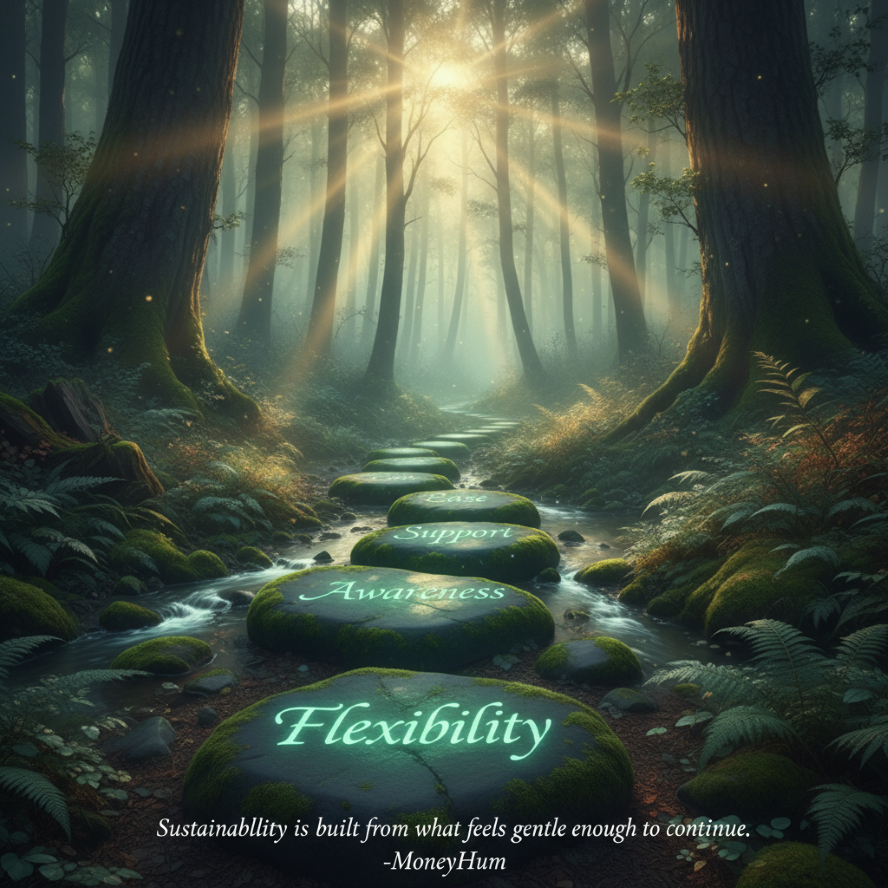
The Real Reason Most Financial Systems Fail
People don’t fail because they don’t want financial peace.
They fail because:
- they try systems that are too strict
- they rely too much on discipline
- they treat budgeting like punishment
- they ignore emotional triggers
- they exhaust their willpower
- they attempt too much, too fast
- they don’t have support systems
- they don’t account for bad days
- they don’t design for human weakness
- they don’t plan for emotional moments
A sustainable budget must be gentle enough to follow even when you’re tired, sad, discouraged, or overwhelmed.
This chapter teaches you the art of designing for your future tired self, future stressed self, and future emotional self not just your motivated self.
That is real sustainability.
The Psychology of Sustainability: Why You Stick to Some Habits and Abandon Others
Studies in behavioral psychology show that humans stick to habits when:
- the habit requires very low friction
- the habit gives small emotional rewards
- the habit fits naturally into daily routines
- the environment supports the behavior
- the cost of failure is low
- the identity feels aligned (“I’m someone who does this”)
This is why:
- some people go to the gym for years
- some meditate daily
- some maintain journals
- some complete SIPs consistently
- some track spending without burnout
Not because their lives are easier but because their habits are frictionless, integrated, emotionally rewarding, and aligned with identity.
In earlier chapters, we explored the emotional triggers behind overspending. Now we explore the emotional triggers behind consistency.
Understanding this creates a powerful truth:
You don’t stay consistent because you are disciplined. You stay consistent because your system makes consistency inevitable.
This is the philosophy behind building wealth patiently the theme of The Path to Real Wealth: Why Patience and Compounding Beat Shortcuts.
The 4 Things That Destroy Financial Consistency (And How to Fix Them)
There are four subtle forces that break even the best designed money systems.
The key is not to eliminate them but to anticipate them.
1. Motivation Drop (The “I’ll fix it later” spiral)
Motivation is unreliable.
Motivation is emotional.
Motivation rises and falls with your mood, workload, and stress.
This is why relying on motivation for financial habits is doomed from the start.
The fix: Replace motivation with automation.
- SIPs run without motivation
- savings happen without motivation
- bills get paid without motivation
- trackers update without motivation
- dashboards reflect progress automatically
When the system acts without your involvement, consistency becomes your default.
This is the emotional protection layer we discussed in Emergency Fund Mastery: How Much You Need, Where to Keep It because systems protect you when motivation fades.
2. Emotional Spending Waves (Triggered by stress, fatigue, loneliness, boredom)
Even emotionally intelligent people fall into emotional spending cycles.
Why?
Because emotions are stronger than numbers.
You buy to soothe.
You buy to reward.
You buy to escape.
You buy to feel alive.
You buy to feel in control.
As explained in Emotional Spending Psychology: Why We Buy What We Don’t Need, every purchase carries emotional meaning.
The fix: Build emotional cushions inside your system
- have a “pleasure budget” you can spend guilt free
- use digital friction (no saved cards, app deletes during stressful periods)
- switch to cash for vulnerable categories
- set up a weekly check in to catch emotional patterns early
- use the “Pause & Name” method: “Am I buying relief or buying value?”
When emotional spending becomes visible, it stops becoming harmful.
3. Overwhelm (Too many tools, too many rules)
People don’t give up because budgeting is hard.
They give up because budgeting feels mentally heavy.
Too many apps → abandon.
Too many categories → abandon.
Too many goals → abandon.
Too many restrictions → abandon.
The fix: Radical simplification
Your ecosystem must be light, not heavy.
- 1 spending tracker
- 1 investment platform
- 1 dashboard
- 1 review ritual
- 1 savings automation
- 2 categories to control
- 1 emergency fund
Minimal structure → deep calm.
This is the core philosophy of designing dashboards, as explained in Your Financial System Needs a Dashboard — Not Just Dreams.
4. Life Events (unexpected expenses, job change, travel, illness, family pressure)
Every financial life will face:
- emergencies
- high expense months
- surprise bills
- festivals
- weddings
- travel plans
- career slowdowns
- burnout seasons
Most systems fail here.
Not because they are bad but because they are inflexible.
The fix: Build elasticity
A sustainable system must expand and contract with your life.
This means:
- flexible category limits
- guilt free pause months
- seasonal budgets
- multiple savings buckets (sinking funds)
- an emergency fund that absorbs shocks
- a 10 minute ritual that resets the system
Elasticity preserves emotional well being.
Elasticity preserves dignity.
Elasticity preserves consistency.
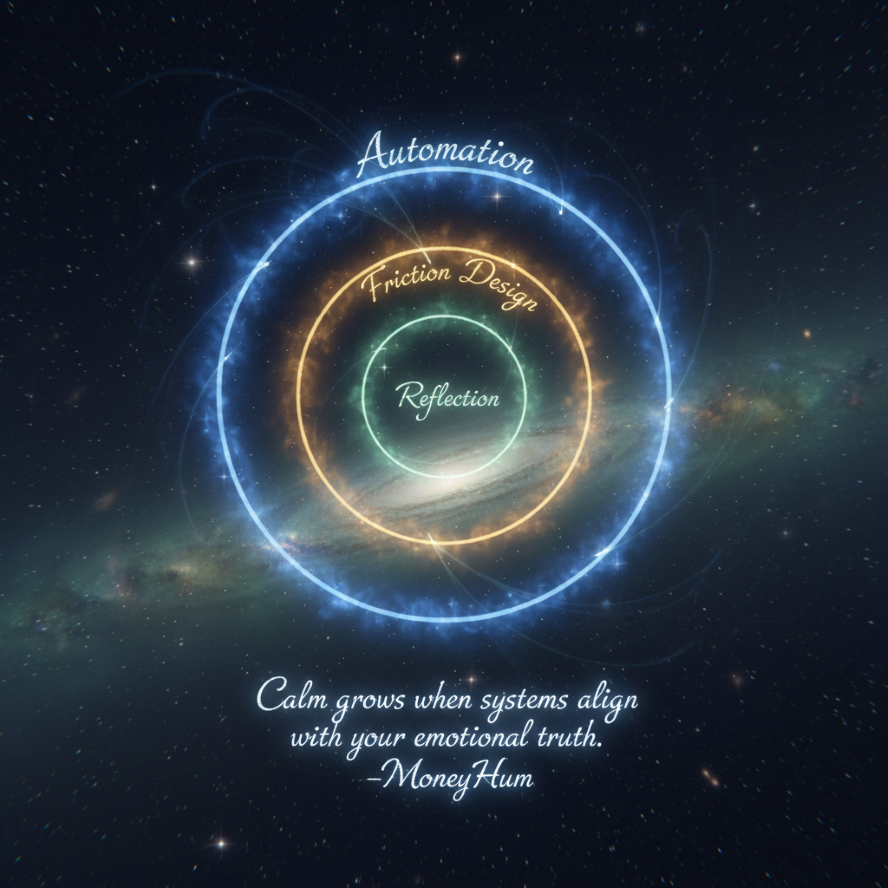
The Core Framework of Sustainability: “The 3 Layers of Financial Calm”
To stay consistent long term, your system needs these three layers:
LAYER 1 AUTOMATION (Protects Your Future Self)
This is the non negotiable layer.
- SIPs
- payday savings transfer
- bill payments
- emergency fund contributions
- credit card due date automation
- subscription tracking
Automation eliminates dips in discipline.
LAYER 2 FRICTION DESIGN (Protects Your Emotional Self)
Humans repeat easy behaviors and avoid difficult ones.
Make bad habits harder:
- delete shopping apps during stressful weeks
- remove saved cards
- disable one tap checkout
- unsubscribe from promotional emails
- use cash for vulnerable categories
Make good habits easier:
- automatic tracking
- pre set SIP dates
- auto reminders
- minimalist dashboards
- easy reviewing rituals
Friction is emotional architecture.
LAYER 3 REFLECTION (Protects Your Present Self)
Reflection is the emotional glue that holds your system together.
Your weekly review ritual is where:
- you catch patterns
- you redirect energy
- you reset boundaries
- you understand yourself
- you adjust goals
- you regain calm
- you learn from mistakes
Reflection turns chaos into wisdom.
This aligns with the deeper life evaluation approach explored in How to Measure Real Progress in Life When Money Isn’t Enough because financial clarity mirrors life clarity.
The 10 Minute Weekly Ritual (Your Sustainability Anchor)
Let’s expand this beautifully simple ritual:
1. Check your spending tracker (2 minutes)
Just observe no judgment.
2. Check your categories (2 minutes)
Notice emotional trends.
3. Check your upcoming bills (1 minute)
Future you will thank you.
4. Check your SIPs & investments (2 minutes)
Feel the progress emotional reward.
5. Check your dashboard (2 minutes)
Acknowledge clarity.
6. Set one intention for the next week (1 minute)
One small shift → huge compounding.
This ritual is not for discipline.
It is for peace.
It creates predictability.
Predictability creates safety.
Safety creates sustainability.
What to Do When You “Fall Off”: The Relapse Protocol
Relapse is normal.
Relapse is human.
Relapse is expected.
Here is the protocol to fix any bad month:
STEP 1: Don’t judge yourself
Shame kills consistency faster than mistakes.
STEP 2: Reset your dashboard
Press “clear.” Start fresh.
STEP 3: Identify the emotional trigger
Stress? Loneliness? Fatigue? Excitement?
STEP 4: Contain, don’t punish
Cut only one or two categories next month.
STEP 5: Reset automation
Ensure SIPs and savings are restored.
STEP 6: Rebuild slowly
One good week → becomes two → becomes momentum.
The goal is not perfection.
The goal is continuity.
This mirrors the gentle approach advocated in The Hidden Cost of Constant Hustle ease over force.
The Emotional Gain: What Sustained Financial Clarity Feels Like
Sustainability brings something deeper than financial progress.
It brings:
- calm mornings
- guilt free purchases
- predictable months
- quiet confidence
- reduced anxiety
- emotional stability
- relationship harmony
- better sleep
- higher self respect
- life satisfaction
You no longer fear bills.
You no longer feel lost.
You no longer overspend unconsciously.
You no longer wonder “where did my money go?”
Instead, you live with:
- choice
- intention
- awareness
- alignment
Financial consistency becomes emotional maturity.
Emotional maturity becomes life stability.
This is real wealth.
CHAPTER VI: Goal Based Budgeting: Transforming Dreams into Achievable Financial Targets
Most people don’t struggle with money because they lack discipline.
They struggle because they don’t have clarity.
Clarity is emotional.
Clarity is directional.
Clarity is grounding.
When you know exactly what your money is doing and why you stop feeling scattered and start feeling stable.
Goal based budgeting is not about restricting your spending.
It is about aligning your financial decisions with your life’s deeper purpose.
It is the art of taking dreams vague, emotional, exciting dreams and turning them into structured steps, predictable timelines, and achievable targets.
Because a goal without structure becomes anxiety.
But a goal with structure becomes peace.
This chapter will guide you through that transformation.
The Hidden Truth About Financial Goals: Dreams vs. Defined Targets
Everybody has financial dreams.
But very few have financial goals.
Dreams feel like:
- “I want to travel more.”
- “I want a bigger home.”
- “I should start investing.”
- “I want financial stability.”
- “I want to quit my job someday.”
- “I want to be debt free.”
- “I want to build wealth.”
Dreams are emotional.
Goals are defined.
Dreams inspire.
Goals execute.
Goal based budgeting doesn’t kill the dream it makes the dream real.
The emotional relief that flows from clarity is similar to the peace described in How to Measure Real Progress in Life where measurable steps replace vague stress.
The Three Layers of Goals: Short, Medium, and Long Term Planning
A sustainable financial life needs all three layers because each one satisfies a different emotional need.
1. Short Term Goals (0–12 months)
Emotion: Relief, control, quick reward
Examples:
- Build emergency fund
- Close one debt
- Save for a small trip
- Build a skills fund
- Replace a laptop/phone
Short term goals reduce anxiety by giving you quick wins.
2. Medium Term Goals (1–5 years)
Emotion: Stability, predictability, growth
Examples:
- Down payment for a house
- Career development courses
- A major travel plan
- Wedding fund
- Car fund
- Building a modest investment base
Medium term goals give direction and purpose.
3. Long Term Goals (5–25 years)
Emotion: Peace, identity, future security
Examples:
- Retirement
- Wealth compounding
- Big property goals
- Children’s education
- Financial independence
Long term goals create emotional safety.
This categorization is the foundation of what makes SIP based investing powerful thoroughly explored in Build a Strong SIP Habit, where long term consistency drives exponential peace.
The Psychology of Goal Based Budgeting: Motivation and Meaning
Why does goal based budgeting work so well?
Because humans are motivated by meaning, not discipline.
When your money has purpose:
- spending becomes aligned
- savings feel meaningful
- investing feels exciting
- guilt disappears
- momentum builds naturally
- emotional spending declines
- impulsive behavior drops
- resilience increases
Purpose shapes behavior more effectively than restrictions ever will.
This is the same motivational architecture that explains why compounding beats shortcuts the core insight in The Path to Real Wealth.
Step 1: Turning Vague Dreams into Clear, Well Defined Goals

Let’s transform vague dreams into clear targets.
For each dream, answer three questions:
Q1: How much will it cost?
You don’t need perfect numbers estimates are enough.
Q2: When do you want it?
6 months? 2 years? 10 years?
Q3: How emotionally important is it?
Low → Medium → High → Very High
These three answers will create your roadmap.
For example:
Dream: “I want to travel to Europe.”
- Cost estimate: ₹2.5 lakh
- Timeline: 18 months
- Emotional priority: High
Boom now it’s a goal.
Step 2: Translate Each Goal into Predictable Monthly Contributions
This is the part most people skip and the part that creates 95% of financial anxiety.
Once you know the total amount and the timeline, calculate the monthly requirement.
Example:
Europe trip (₹2.5 lakh) with an 18 month timeline:
₹2,50,000 ÷ 18 ≈ ₹13,900/month
Suddenly the dream becomes predictable.
Suddenly the anxiety drops.
Suddenly the goal becomes manageable or adjustable.
This clarity is what turns emotional desire into emotional calm.
Step 3: Choose the Right Investment Vehicle for Each Goal’s Timeline
This is critical.
Different goals require different tools.
A) Short Term Goals → Savings / Liquid Funds
Why?
Market volatility can hurt short term targets.
Use:
- high interest savings account
- liquid mutual funds
- recurring deposits
This approach is consistent with the risk framework in Emergency Fund Mastery.
B) Medium Term Goals → Balanced Investing
Use:
- SIPs in hybrid funds
- SIPs in index funds
- Targeted savings accounts
C) Long Term Goals → Equity Focused Investing
For long term goals, equity outperforms almost all other tools a truth explored in Investing Beyond Gold & FDs.
Use:
- equity mutual funds
- index funds
- long term SIPs
- ELSS (if tax benefits needed)
Aligning the right tool to the right timeline is one of the most emotionally relieving things you can do.
Suddenly the future feels safe.
Suddenly the process becomes automatic.
Step 4: Automate Every Goal for Effortless Consistency
The chapter would be incomplete without automation.
Automation makes goal based budgeting:
- effortless
- consistent
- resilient
- emotionally steady
For each goal:
- Set a SIP (investing goal)
- Set a recurring transfer (savings goal)
- Set reminders (tracking goal)
Automation creates trust.
You stop worrying.
The system takes over.
Automation is self compassion in financial form.
Step 5: Prioritize Your Goals and Reduce Guilt with a Clear Formula
You cannot fund every dream at once.
But you can fund every dream over time.
Use this priority formula:
1. Non Negotiable Goals (Must)
Emergency fund
Insurance
Debt repayment
Basic retirement
2. High Priority Goals (Need)
Career development
Big future plans
Mid term lifestyle dreams
3. Medium Priority Goals (Want)
Travel
Hobbies
Small lifestyle upgrades
4. Low Priority Goals (Nice to Have)
Aesthetic purchases
Tech upgrades
Luxury experiences
This prioritization reduces guilt.
It turns chaos into clarity.
It also reduces impulsive identity driven spending the phenomenon explained in How Gen Z & Young Professionals Manage Money, where identity purchases often overshadow real priorities.
The Role of Emotional Alignment: Matching Goals to Your Season of Life
There are seasons of life:
- career building
- income growth
- debt repayment
- self discovery
- family responsibilities
- healing periods
- restful seasons
- adventurous seasons
Your goals must reflect your emotional season, not societal timelines.
A 25 year old in a career sprint needs different goals from a 40 year old craving stability.
A young professional struggling with burnout may need fewer goals and more emotional breathing room.
A family focused person may need more safety goals (insurance, education funds).
A creative soul may need a “freedom fund.”
Your system should support your soul, not suffocate it.
Building Your Goal Dashboard: Visibility for Emotional Confidence
This is the heart of goal based budgeting.
Your dashboard should include:
- each goal
- total amount needed
- timeline
- monthly contribution
- progress bar
- estimated completion date
A dashboard makes your dreams visible.
Visibility creates motivation.
Motivation creates momentum.
Momentum creates identity.
This is why dashboards are strongly emphasized in MoneyHum they transform emotional fog into emotional confidence, as detailed in Your Financial System Needs a Dashboard.
The Emotional Benefits of Goal Based Budgeting
Once your goals are structured, several things shift internally:
You no longer overspend mindlessly.
Because your goals feel real.
You no longer feel guilty for enjoying life.
Because pleasure spending fits within boundaries.
You no longer fear the future.
Because you are preparing for it.
You no longer feel forced to “cut costs.”
Because you’re realigning, not restricting.
You no longer compare yourself to others.
Because your goals reflect your life, not theirs.
You no longer chase risky shortcuts.
Because long term clarity eliminates impulse investing the trap we discuss in Why You Keep Chasing Quick Profits.
Goal based budgeting creates emotional clarity.
Emotional clarity creates financial peace.
The Transformation Moment: When Dreams Become Measurable Progress
There comes a moment it could be during your Sunday check in when you look at your dashboard and see a progress bar move.
Just a little.
But that little movement changes something inside you.
You feel capable.
You feel grounded.
You feel safe.
You feel hopeful.
You feel proud.
You feel at peace.
This is the emotional payoff of goal based budgeting:
Progress becomes visible.
Hope becomes predictable.
Dreams become achievable.
This is financial adulthood in its most gentle, human form.
CHAPTER VII: The Money Mind Connection: Healing Fear and Rewiring Financial Beliefs
You can automate your savings.
You can build a dashboard.
You can follow a budget.
You can track expenses.
You can design an entire ecosystem.
And yet…
If a part of you still feels unsafe, unworthy, fearful, or uncertain around money, the system will always feel heavier than it should.
Because money is not just numbers.
Money is memory.
Money is survival.
Money is identity.
Money is trauma.
Money is culture.
Money is childhood lessons.
Money is emotion.
Money is meaning.
The mind doesn’t treat money as currency.
It treats money as psychology.
Every rupee you spend is a reflection of your beliefs.
Every rupee you save is a reflection of your safety.
Every investment you delay is a reflection of your fear.
Every overspend is a reflection of your emotional needs.
Every financial dream is a reflection of your identity.
If your beliefs are not healed, your system will always feel like a battle.
But when your beliefs shift even slightly money becomes lighter, softer, easier.
In this chapter, we gently explore the deeper emotional and psychological layers of money, so your external systems align with your internal reality.
The Quiet Root of Most Money Problems: Inherited Financial Beliefs
Researchers in behavioral psychology have repeatedly shown that people do not behave according to logic they behave according to beliefs formed long before adulthood.
Your money behavior today is shaped by:
- what you saw growing up
- what you heard about money
- what you learned in early adulthood
- how your caregivers handled money
- your first experiences with earning
- your relationship with risk
- your relationship with fear
- your emotional wounds
Your “inner money script” runs quietly in the background of your life.
Unless you update it, the script controls you.
This is why many people:
- earn well but still feel broke
- save but feel unsafe
- invest but feel anxious
- overspend to feel seen
- underinvest due to fear
- chase shortcuts due to insecurity
- avoid budgets because they fear restraint
- feel guilt around pleasure spending
- fear checking their bank balance
Money is emotional before it is practical.
Always.
This emotional truth is the core of several MoneyHum explorations especially Financial Anxiety Is the Modern Disease, which explains how modern stress reshapes our relationship with money.

The Three Subconscious Money Identities: Survivor, Pleaser, and Controller
There are three dominant internal identities people unconsciously carry:
- The Survivor
- The Pleaser
- The Controller
Each one shapes financial choices uniquely.
Let’s explore them gently.
1. The Survivor (Fear Based Identity)
The Survivor grew up hearing:
- “Money is always tight.”
- “We can’t afford this.”
- “Save everything you can.”
- “Life is uncertain.”
Survivors tend to:
- fear spending
- delay investments
- avoid financial risks
- hold too much cash
- feel unsafe even with savings
- underspend on comfort
- feel guilty buying things
Their inner voice always says:
“What if something goes wrong?”
Survivors need emotional safety, not judgment.
They need structured savings, emergency funds, and dashboards that reassure the kind created through Emergency Fund Mastery.
2. The Pleaser (Approval Based Identity)
The Pleaser learned that:
- love is connected to generosity
- approval follows spending
- belonging requires lifestyle matching
- gifts, treats, or outings equal connection
Pleasers tend to:
- overspend socially
- avoid saying “no”
- carry guilt around boundaries
- upgrade lifestyle too quickly
- buy to feel accepted
- seek identity through purchases
Their inner voice says:
“I must show love through spending.”
Pleasers need emotional boundaries and gentle structure something that grows naturally through goal based budgeting (explored in Chapter 6).
3. The Controller (Perfection Based Identity)
The Controller learned:
- “Money must never be misused.”
- “Every rupee must be tracked.”
- “Financial mistakes are unacceptable.”
- “Success depends on control.”
Controllers tend to:
- over analyze
- stress about tracking
- feel guilty when spending
- micromanage budgets
- freeze during uncertainty
- over plan every detail
Their inner voice says:
“If I don’t control everything, things will fall apart.”
Controllers need emotional flexibility the kind introduced in Chapter 5’s sustainability principles.
Which Money Identity Are You?
Most people are a blend of all three.
One identity leads, the others whisper.
Understanding your identity doesn’t limit you.
It frees you.
You cannot build a peaceful financial life while fighting your identity.
But you can build one that supports your identity.
This is where healing begins.
The Psychology of Financial Fear and Its Four Major Types
Financial fear is not about money.
It’s about meaning.
Humans fear:
- scarcity
- unpredictability
- loss
- shame
- judgment
- failure
- regret
- emotional exposure
Money is simply the place where these fears become visible.
This fear often drives people into shortcuts a phenomenon we discuss in Why You Keep Chasing Quick Profits because fear seeks fast solutions.
But healing begins when you understand the source of the fear.
There are four major types:
1. Fear of Not Having Enough
Born from unpredictability.
2. Fear of Losing What You Have
Born from attachment.
3. Fear of Missing Out (FOMO)
Born from comparison.
4. Fear of Making a Wrong Decision
Born from perfectionism.
Each fear needs a different type of emotional support:
- structure
- boundaries
- clarity
- patience
- self trust
Let’s build that support now.
Rewiring Your Money Beliefs: The 5 Pillar Inner Work Process
Your external systems (automation, dashboards, budgets) will only be as strong as your inner system your beliefs.
This process helps you rewire those beliefs without pressure.
Pillar 1: Recognize the Financial Belief
A belief is simply a thought repeated for years.
Write down what you subconsciously believe about money:
- “Money is hard.”
- “I’m bad with money.”
- “I don’t deserve wealth.”
- “I need to spend to feel valued.”
- “Investing is risky.”
- “Budgeting is restrictive.”
- “I must keep up with others.”
- “Wealthy people are greedy.”
Awareness dissolves emotional fog.
Pillar 2: Identify the Belief’s Origin
Ask gently:
“Where did I learn this?”
You’ll realize:
- it wasn’t your belief
- it was inherited
- it was observed
- it was taught
- it was cultural
- it was emotional
- it was circumstantial
Once you see the origin, the belief loses power.
Pillar 3: Create a New, Grounded Money Belief
Not a positive affirmation.
A grounded, realistic, emotionally aligned belief.
Examples:
Old belief → “I’m bad with money.”
New belief → “I’m learning to understand money.”
Old belief → “Spending makes me feel worthy.”
New belief → “My worth is not dependent on spending.”
Old belief → “Investing is risky.”
New belief → “Not investing is riskier.”
Old belief → “Budgeting restricts me.”
New belief → “Budgeting frees me.”
A belief must feel true not forced.
Pillar 4: Prove the New Belief with Small Financial Wins
Create small wins:
- automate one SIP
- track one category
- save a small amount
- pay one bill early
- build one dashboard
- avoid one emotional purchase
- complete one weekly check in
Each small win rewires your brain.
Each win becomes evidence.
Compounding isn’t just financial.
It’s emotional.
Pillar 5: Integrate the New Belief into Your Financial Identity
Identity locks behavior into place.
Say softly:
“I am someone who takes care of my money.”
“I am someone who makes intentional choices.”
“I am someone who prepares for the future.”
“I am someone who builds emotional safety.”
“I am someone who grows wealth patiently.”
This identity shift is what transforms short term efforts into long term calm just as compounding transforms small contributions into wealth, as explained in The Path to Real Wealth.
Healing Money Anxiety: 5 Calming Techniques
Money anxiety is not a sign of weakness.
It is a sign of emotional overload.
Here are gentle techniques to calm it:
1. The Three Breath Reset
Before any money decision, pause for three slow breaths.
You reset the emotional brain and activate the rational one.
2. The “Name the Feeling” Technique
“I’m not scared of money I’m scared of uncertainty.”
Naming the emotion makes it manageable.
3. The “Open the Dashboard” Habit
Anxiety grows in darkness.
Dashboards create light.
4. The “One Small Action” Rule
Anxiety decreases when action begins.
- Update your spending tracker
- Recheck your SIPs
- Clear your email receipts
- Review your emergency fund
- Identify one subscription to cancel
Small steps ground you.
5. The “Don’t Decide Today” Rule
When overwhelmed, postpone decisions for 24 hours.
This breaks emotional cycles.
These techniques echo the deeper healing frameworks discussed in Financial Anxiety Is the Modern Disease.
The Transformation Moment: When Inner Identity and Outer System Match
There comes a day and it’s always subtle when you notice your reactions have changed.
You check your bank balance without fear.
You pay bills on time without anxiety.
You invest without overthinking.
You save without guilt.
You spend intentionally.
You feel safe buying what you love.
You feel grounded avoiding what isn’t aligned.
You feel peaceful knowing your future is supported.
This is financial maturity.
Not perfection.
Not wealth.
Not income.
Peace.
Steadiness.
Emotional clarity.
Self trust.
This is what the Money Mind connection creates.
You are no longer reacting to money.
You are relating to money.
Money stops being a source of fear.
It becomes a partner in your life.
CHAPTER VIII: Quiet Mastery: Living a Calm, Intentional, and Digitally Aligned Financial Life

By the time you reach this chapter, something subtle has already begun shifting inside you.
You may not have noticed it fully yet, but the shift is real:
- You understand your emotions more clearly.
- You see your spending patterns with greater honesty.
- You know that your brain, not your character, drives many money decisions.
- You feel calmer knowing that visibility and systems are on your side now.
- You’ve started building an ecosystem that supports your life, not constrains it.
- Your goals have moved from dreams into numbers and numbers into progress.
- Your beliefs about money are softening, rewiring, and becoming kinder.
This final chapter is not about adding more rules or tools.
It’s about stepping back and seeing the complete picture of your financial life not as tasks, not as habits, not even as goals, but as a quiet, intentional way of being.
Quiet mastery is not perfection.
Quiet mastery is alignment.
Alignment between:
- your mind
- your habits
- your systems
- your identity
- your digital environment
- your emotional needs
- your long term purpose
When these align, your financial life becomes a gentle hum, not a storm.
Let’s bring everything together.
The True Purpose of Budgeting: Restriction vs. Peace
For years, budgeting has been framed as:
- cutting costs
- tracking expenses
- saying no
- restricting pleasures
- fighting impulses
But all these ideas come from a fear based philosophy one that assumes money is scarce, fragile, and stressful.
Quiet mastery introduces a new worldview:
Budgeting is not restriction. Budgeting is self respect.
Budgeting is:
- choosing what matters
- redirecting your energy
- supporting your future
- honoring your emotional patterns
- giving structure to your dreams
- designing your environment
- calming the chaos
- creating predictability
- building self trust
This aligns with the gentle reason behind behavioral frameworks like The 50/30/20 Rule not to restrict life, but to make life easier.
When you see budgeting as respect instead of restriction, everything becomes lighter.
The Paradox of Quiet Mastery: Gaining Control by Designing Structure
People who are financially anxious often believe:
- “I must control everything.”
- “I must track every rupee.”
- “I must never make a mistake.”
- “I must always be disciplined.”
But emotional mastery teaches a different truth:
The more control you try to impose, the more unstable you feel. The more structure you gently design, the more naturally things fall into place.
Control is rigid.
Structure is supportive.
Control exhausts.
Structure reassures.
Control collapses.
Structure sustains.
Quiet mastery emerges when your systems are so well designed digitally and emotionally that they require almost no force from you.
This is the same principle behind dashboards, as explored in Your Financial System Needs a Dashboard.
A good system reduces your need for control.
The Four Signs of a Quietly Mastered Financial Life
Quiet mastery is not loud.
It doesn’t look like sudden wealth, dramatic changes, or perfect tracking.
It reveals itself slowly, in everyday calm.
Here are the four markers:
1. Your Money Behaves Even on Your Worst Days
This means:
- your SIPs run
- your savings flow
- your bills pay themselves
- your dashboard stays updated
- your categories auto track
- your goals progress slowly but surely
Your system protects you during overwhelm, fatigue, or stress.
This is emotional freedom.
2. You Spend With Intention Instead of Impulse
This does not mean you never splurge.
It means:
- you splurge with awareness
- you spend without guilt
- you recognize triggers
- you can catch yourself mid impulse
- your desires feel grounded, not chaotic
This reflects the emotional intelligence built in Chapters 2 and 7 especially the insights from Emotional Spending Psychology.
3. You Feel Safe Looking at Your Financial Numbers
One of the quietest forms of healing is this:
You open your banking app without panic.
You check your expenses without shame.
You review your dashboard without dread.
Clarity has replaced fear.
This emotional safety is the goal behind the automation systems and awareness rituals laid out in earlier chapters.
4. Your Future Feels Predictable and Supportive
Not rigid.
Not stressful.
Not overwhelming.
Predictable.
Because your:
- income
- expenses
- savings
- investments
- goals
- dreams
are connected through a calm, consistent system.
This is what The Path to Real Wealth describes wealth as a slow, peaceful process built on steady habits, not big leaps.
Digital Alignment: Letting Technology Carry the Financial Mental Load
Quiet mastery in a digital age means using technology thoughtfully, not passively.
Digital alignment means:
- letting apps track your spending for you
- letting dashboards simplify your numbers
- letting automation run your savings
- letting reminders prevent late fees
- letting category insights show emotional patterns
- letting SIPs compound wealth without effort
Technology should reduce your:
- guilt
- confusion
- overwhelm
- forgetfulness
- emotional spending
- micromanaging
When used intentionally, digital tools create spaciousness.
A quiet mental landscape.
Financial peace.
This is why this entire journey includes references to digital intelligence from Emergency Fund Mastery to dashboards, SIP habits, and modern spending psychology.
You are not meant to carry everything in your mind.
Your digital ecosystem exists to support your emotional life.
Inner Alignment: The Calm Financial Identity You Grow Into
Quiet mastery is not just systems.
It is an identity.
A softly evolving identity that sounds like this:
- “I trust myself with money.”
- “I choose intentionally.”
- “I know my patterns, and I respect them.”
- “I prepare for the future gently, consistently.”
- “I spend without shame, save without fear, and invest without pressure.”
- “I am building something peaceful.”
When your identity shifts,
your behavior follows,
your systems sustain,
your goals align,
your emotions calm.
Identity is the deepest layer of financial stability.
This is why Chapter 7 focused so heavily on beliefs and subconscious patterns.
Your inner world is the foundation of your outer financial life.
Quiet Mastery: The 5 Essential Financial Habits
If you carry only five habits from this book, let them be these:
1. Weekly 10 Minute Check In
Your anchor.
Your compass.
Your moment of truth.
It doesn’t need discipline.
It needs presence.
Just 10 minutes.
2. One Dashboard Your Life in One View
Your financial mirror.
Your emotional grounding.
Clarity creates calm.
3. Automated Essentials
Savings
Investments
Bills
Subscriptions
Credit card dues
Let automation take care of the future.
Let your mind take care of the present.
4. Intentional Spending (Pause, Notice, Choose)
This simple three step awareness loop reduces emotional spending dramatically.
It reconnects you to yourself.
5. One Small Adjustment Every Month
Not ten changes.
Not full resets.
Not extreme discipline.
Just one shift.
Small steps compound quietly.
These five habits are the essence of sustainable financial adulthood the same core philosophy behind the long form systems described across this entire journey.
The Long Term Philosophy of Quiet Mastery
If you zoom out and look at your entire financial life decades, not months a truth emerges:
Your life will not be shaped by big decisions. It will be shaped by hundreds of small ones made calmly, consistently, intentionally.
- Tracking without obsession.
- Spending without guilt.
- Saving without fear.
- Investing without hesitation.
- Learning without pressure.
- Adjusting without shame.
- Growing without comparing.
This is quiet mastery.
A slow, stable, gentle evolution.
No drama.
No intensity.
No perfection.
Just consistent peace.
The same way a SIP grows in the background silently, steadily your emotional mastery grows quietly.
This philosophy is the heart of MoneyHum:
Simple tools.
Deep emotional insight.
Calm financial growth.
The Final Transformation Moment
At some point perhaps months from now you will realize that money is no longer a loud presence in your life.
The storm is gone.
The static is quiet.
The noise is dimmed.
In its place is:
A sense of order.
A sense of clarity.
A sense of knowing.
A sense of safety.
A sense of groundedness.
You will make decisions without fear.
You will invest without overthinking.
You will spend without guilt.
You will save without pressure.
You will plan without panic.
Quiet mastery is a financial identity but it is also a way of living.
It is gentle.
It is aware.
It is patient.
It is wise.
It is calm.
It is the end of this book and the beginning of your new relationship with money.
Closing Arc of Chapter 8 (And the Entire Journey)
You started this journey with a storm inside you.
You leave it with an ecosystem.
With clarity.
With meaning.
With emotional intelligence.
With structure.
With tools.
With resilience.
With peace.
With quiet mastery.
Your financial life is now aligned
with your purpose,
your psychology,
your digital world,
your goals,
and your identity.
This is not the end.
This is the stabilizing beginning.
Whenever you feel lost, return to:
- your dashboard
- your weekly ritual
- your automated flows
- your goals
- your emotional awareness
- your identity
- your gentleness
Money becomes peaceful when you become peaceful.
Thank you for walking this journey so deeply, so honestly, so humanly.
If you’ve read this till the end, thank you❤️
With love,
Your Dearest Friend,
Chitraansh
Key Takeaways: Summary of Financial Peace Principles
1. Money is Emotional Before It Is Mathematical
Your spending, saving, and investing behaviors are shaped far more by psychology, identity, childhood patterns, and emotional triggers than by logic alone.
Related piece: Emotional Spending Psychology
2. Visibility Reduces Anxiety More Than Income Does
When money feels invisible scattered accounts, unclear expenses, forgotten subscriptions your brain fills in the gaps with fear.
Dashboards and trackers create emotional safety through clarity.
Related piece: Your Financial System Needs a Dashboard
3. Automation is Emotional Protection, Not a Feature
Automated savings, SIPs, bill payments, and transfers protect your future self on your worst days when discipline is lowest and emotions are highest.
Related piece: Build a Strong SIP Habit
4. Budgeting Is Not Restriction It Is Self Respect
A budget is simply a tool that aligns your spending with what you truly value.
It doesn’t limit life; it liberates it.
Related piece: The 50/30/20 Rule
5. Emotional Triggers Drive Overspending Not Irresponsibility
Fatigue, stress, loneliness, and identity seeking quietly shape daily purchases.
Once you see the pattern, regret dissolves, and intentionality grows.
6. A Sustainable System Is Simple, Not Perfect
Quiet mastery comes from:
- one dashboard
- one tracker
- one investment platform
- one 10 minute weekly check in
- one small improvement each month
Related piece: The Hidden Cost of Constant Hustle
7. Small Monthly Actions Compound More Than Dramatic Changes
Wealth and emotional peace grow through slow, steady, consistent actions not intensity or shortcuts.
Related piece: The Path to Real Wealth
8. Your Financial Identity Shapes Your Financial Destiny
When you shift your identity to:
“I am someone who takes care of my money,”
your habits follow effortlessly.
9. Goal Based Budgeting Turns Dreams into Structure
Life becomes calmer when your dreams have timelines, monthly numbers, and the right investment vehicles.
Related piece: Investing Beyond Gold & FDs
10. Peace Is the Ultimate Goal Not Perfection
A mature financial life feels quiet, grounded, predictable, supportive, and emotionally aligned.
FAQs: Budgeting in the Digital Age Your Most Common Questions Answered
1. “Why do I feel anxious about money even when I earn well?”
Because anxiety isn’t triggered by income it’s triggered by uncertainty and invisibility.
Even high earners feel unsafe when they lack clarity.
Read more: Financial Anxiety Is the Modern Disease
2. “What’s the best budgeting method for beginners?”
Start with the 50/30/20 Rule:
- 50% needs
- 30% wants
- 20% savings/investing
Emotionally simple, mathematically grounded, and easy to automate.
Explore the full guide: The 50/30/20 Rule
3. “Which apps should I use for budgeting?”
You only need four tools:
- one spending tracker
- one investment platform
- one savings home
- one financial dashboard
Minimal tools → maximum calm.
4. “How do I stop emotional spending?”
Use the Pause–Notice–Choose technique:
- Pause
- Name the feeling
- Choose intentionally
Understanding your emotional triggers is step one.
Related: Emotional Spending Psychology
5. “What’s the first investment I should start?”
For most beginners: a long term SIP in a broad market index fund.
Simple, low cost, and time tested.
Learn more: How to Choose the Right Mutual Fund
6. “How much should I keep in my emergency fund?”
Ideally 3–6 months of expenses, stored in a liquid, easily accessible place.
Full breakdown: Emergency Fund Mastery
7. “Why do I keep chasing quick profits or trading aggressively?”
Because the emotional brain craves speed, certainty, and excitement during uncertainty.
Learn the psychology behind it: Why You Keep Chasing Quick Profits
8. “How do I measure progress if I’m not saving a lot yet?”
Measure mindset, clarity, consistency, and awareness not just numbers.
True progress is emotional first, financial second.
Read: How to Measure Real Progress in Life
9. “How do I make budgeting sustainable?”
Use environmental design:
- automation
- simple tools
- weekly check ins
- eliminating friction
- emotional awareness
Explored deeply in Chapter 5.
10. “How do I create long-term wealth without stress?”
Use systems, not motivation:
- SIPs
- dashboards
- simple goals
- patient compounding
Start here: The Path to Real Wealth







